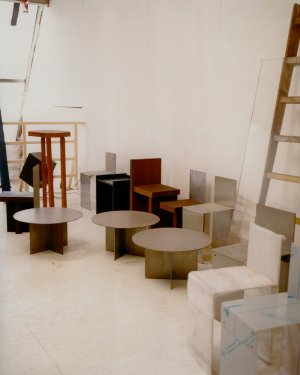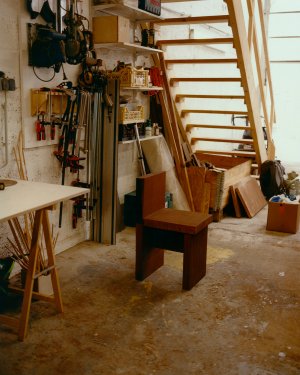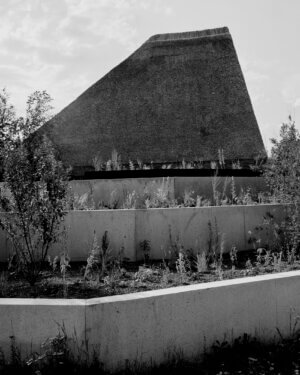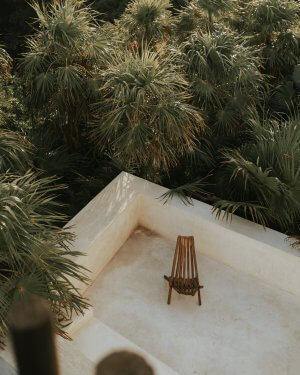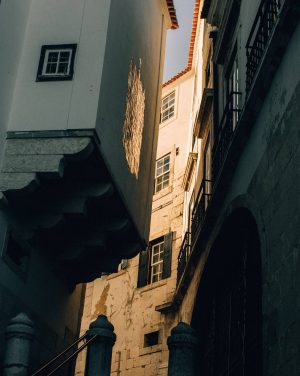Frederik Fialin likes it simple. The Danish designer’s affinity for pared-down, honest, no-frills constructions has guided him from his early apprenticeships through his first independent projects in cabinetmaking and set design to the founding of his own burgeoning furniture practice out of a former aluminum factory in the Neukölln neighborhood of Berlin. It was Frederik’s rigorous simplicity and creative use of materials—from recycled plastic and aluminum to wood left to shine in its imperfection—that set him apart when we went looking for someone to create outdoor furnishings for Flussbad, our riverside campus in Berlin. In creating the pieces, he drew inspiration from the patina and color scheme of the former East German customs building housing the Slowness office, translating them into angular, futuristic pieces in grey, black and earth tones. We caught up with Frederik as he neared completion of the project for the first installment of “Work in Progress,” our series of conversations on the creative process of artists, designers and other Slowness collaborators.
INTERVIEW
Work in Progress
The Designer Creating Futuristic Furniture out of Recycled Materials
In the first installment of our series of conversations on the creative process of artists, designers and other contributors in the world of Slowness, we speak to Frederik Fialin, the up-and-coming Danish furniture designer who created the clean, angular tables and chairs that populate the riverside terrace of Flussbad, our riverside campus in Berlin.
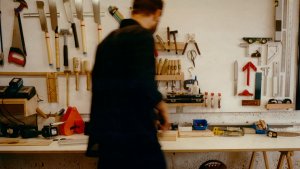
- Photographer Jiuk Kim
In the first installment of our series of conversations on the creative process of artists, designers and other contributors in the world of Slowness, we speak to Frederik Fialin, the up-and-coming Danish furniture designer who created the clean, angular tables and chairs that populate the riverside terrace of Flussbad, our riverside campus in Berlin.
- Photographer Jiuk Kim
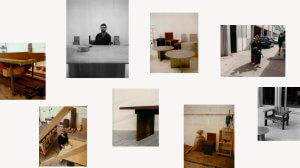
Slowness How did you first get into furniture design?
Frederik I grew up in Fyn in the center of Denmark. I had always been interested in design and art, but I felt like I had to do something more active than I did before. Then all of a sudden I thought, maybe I should be a cabinetmaker. I thought that this might suit me. I took the basic course, and then I got an apprenticeship at a workshop in Copenhagen. I was a bit older than the average apprentice, which turned out to be an advantage actually.
Slowness Why do you think it suits you to make furniture?
Frederik Well my mom is a little handy, but my dad is probably the least handy person I've ever met. So it was very unfamiliar to me in many ways. I used to assemble computers and built them myself and all of this when I was younger, but there was never any practical aspect to my upbringing at all, not even remotely. So it was interesting in that way, because it opened up a whole new realm of possibilities for me as a person, you know? It‘s liberating.
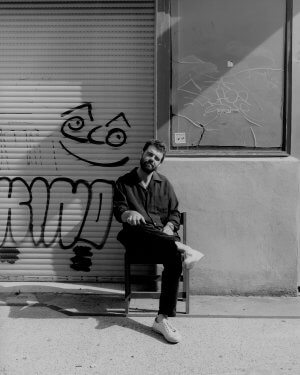
Frederik at his workshop in Neukölln.
Slowness And how has your practice evolved since those early days?
Frederik It has slowly evolved into designing and building, which is quite complicated and time-consuming—usually, it's separated. Cabinetmaking, which just means building furniture and interiors, it’s typically very strict and conservative, especially in Germany. You have to do things in a very specific way. There‘s a set of rules that you have to follow, also when it comes to materials. I was assisting some different kinds of artists and realizing that the world of materials has more to offer. I just started doing some different experiments with steel and metal and aluminum and stuff like this. And slowly it evolved from there, just having a bit of fun really.
Slowness Can you speak a little more about the conservatism you encountered?
Frederik I always thought that all these rules about how a surface has to be absolutely spot-on perfect were super destructive. You have to remove everything that ever resembled the wood, where it was cut, all imperfections have to be removed. You have to use these particular grits of sandpaper in this particular order, and I'm just against it. I think it's an absolute killer. A lot of American woodworkers do this thing I absolutely hate. They create this lacquered, absolutely perfect, shiny surface. Everything that was ever natural about the material is completely gone. I'm really trying desperately to get away from that. I don't want splinters in my ass or anything. But why not keep the scratches in a piece of steel? Why do you necessarily have to spend two days sanding it? That's not how steel looks. Just respect the materials. Try to keep something natural about it.
Slowness Are there examples of this in the work you did for Slowness?
Frederik The wooden tables, for instance, are not even close to being perfect, and it’s not about laziness or our inability to do it to perfection. You can still see slight hints of the saw blade from the sawmill in Africa, for example. I’m not degrading classic craft by any means. I just think that if it’s too perfect, it looks weird. I don’t want to touch it.
“I always thought that all these rules about how a surface has to be absolutely spot-on perfect were super destructive. Just respect the materials. Try to keep something natural about it.”
Slowness How would you describe your design sensibility?
Frederik Just as simple as possible. There are not so many gimmicks. I'm trying to not have any shapes there that are not worth anything. I try to stick to the bare minimum. I think there is something liberating in simplicity. You know these homes from the 1800s that were just completely full of stuff everywhere? All of this is not necessary. I like when it looks sleek and you can see what's going on. There’s no reason to put this makeup on it everywhere. It’s just not me.
Slowness What designers inspire you?
Frederik I like Japanese design and 1960s American minimalism.
Slowness What is your process for choosing materials? Do you think about sustainability?
Frederik Well I would say definitely aesthetics and texture before sustainability, but I try to be sustainable whenever possible. Actually almost every single piece for the Slow terrace is made of recycled plastic. When it comes to Slow, the challenge was what do you do for outdoor furniture? Outdoor furniture is super complicated because if you don't want this classic teak look, then you kind of have to rethink everything. But the real obstacle was, how do you make something that lasts for 5, 10 years, which is not faded by the sun, which doesn't rot, which holds up against the elements. So I was forced to think differently.
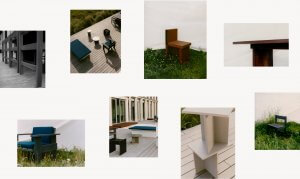
Slowness Why recycled plastic? Was it more convenient than other materials?
Frederik It's actually not convenient. It's expensive as hell, there is nothing convenient about it. And I think that's also one of the big complications of our society is actually that recycled materials and sustainable materials in general are typically way, way more expensive than buying new. We have more plastic than we will ever need. I think that would be one of the coolest things to try to solve on a grand scale.
Slowness Your studio is in an old aluminum factory in Berlin’s Neukölln district. What is it like to be based here?
Frederik It’s such a nice environment out here. You have workshops, creative studios, band rehearsal spaces. You have a pole dancing academy. It’s quite hilarious, the people you see. We all help each other out, helping each other lift things. If you need a bit of welding, you can have it done here. If anyone needs some kind of sandpaper or any materials, we help each other out.
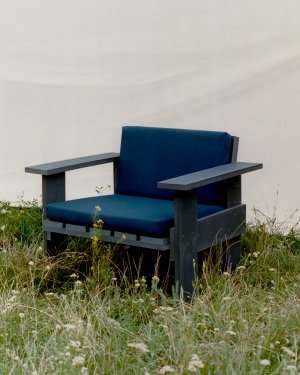
His rigorous simplicity and creative use of materials made Frederik an ideal fit to design and build outdoor furnishings for Flussbad, our riverside campus in Berlin.
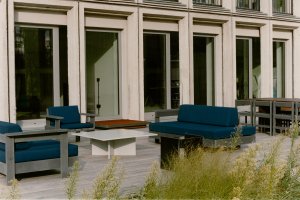
In creating the pieces, Frederik drew inspiration from the patina and color scheme of the former East German customs building housing the Slowness office.
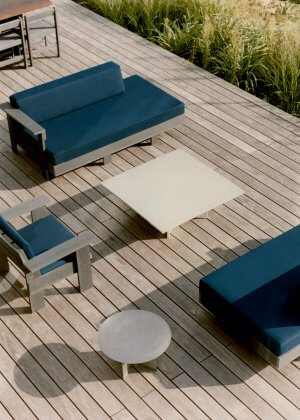
“I'm trying to not have any shapes there that are not worth anything. I try to stick to the bare minimum. I think there is something liberating in simplicity.”
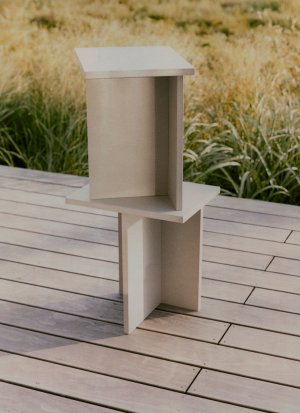
Frederik Fialin’s affinity for pared-down, honest, no-frills constructions has guided him from his early apprenticeships to the founding of his own practice in Berlin.
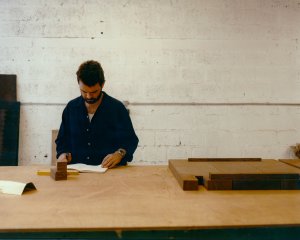
“The real obstacle was, how do you make something that lasts for 5, 10 years, which is not faded by the sun, which doesn't rot, which holds up against the elements?”
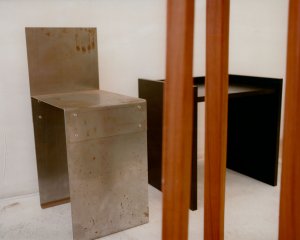
From recycled plastic and aluminum to wood left to shine in its imperfection, Frederik respects the essence of his materials.
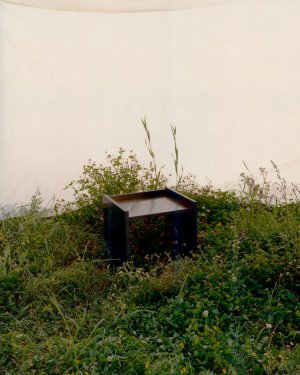
“We have more plastic than we will ever need, but it's very expensive for companies to reuse plastic. I think that would be of one of the coolest things to try to solve on a grand scale.”
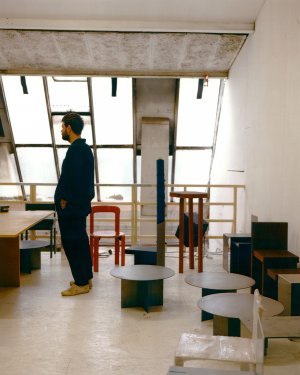
Frederik's studio is located inside a former aluminum factory in Berlin’s Neukölln district.
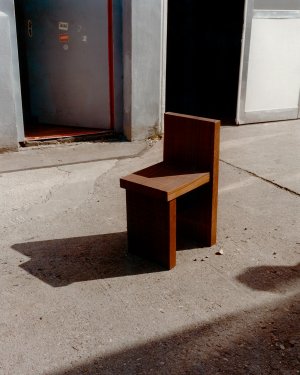
Frederik's signature chair, made from mahogany wood.

His rigorous simplicity and creative use of materials made Frederik an ideal fit to design and build outdoor furnishings for Flussbad, our riverside campus in Berlin.

In creating the pieces, Frederik drew inspiration from the patina and color scheme of the former East German customs building housing the Slowness office.

“I'm trying to not have any shapes there that are not worth anything. I try to stick to the bare minimum. I think there is something liberating in simplicity.”

Frederik Fialin’s affinity for pared-down, honest, no-frills constructions has guided him from his early apprenticeships to the founding of his own practice in Berlin.

“The real obstacle was, how do you make something that lasts for 5, 10 years, which is not faded by the sun, which doesn't rot, which holds up against the elements?”

From recycled plastic and aluminum to wood left to shine in its imperfection, Frederik respects the essence of his materials.

“We have more plastic than we will ever need, but it's very expensive for companies to reuse plastic. I think that would be of one of the coolest things to try to solve on a grand scale.”

Frederik's studio is located inside a former aluminum factory in Berlin’s Neukölln district.

Frederik's signature chair, made from mahogany wood.
Contact
Berlin
Zur Alten Flussbadeanstalt 1
10317 Berlin, Germany
10317 Berlin, Germany
LISBON
Largo de Santa Marinha 1
1100-383 Lisbon, Portugal
1100-383 Lisbon, Portugal
Website by Studio Airport
